Whirligig Beetle
Contact
Katharine Ordway Natural History Study Area9550 Inver Grove Trail Inver Grove Heights, MN 55076 651-455-6204 (On Site)
651-696-6230 (On Campus)
andersonm@macalester.edu
Biotic Inventory: Documenting Diversity at the Katharine Ordway Natural History Study Area
Dineutus hornii, the whirligig beetle
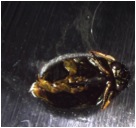
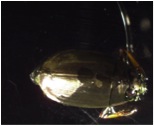
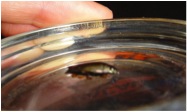
Taxonomy
Kingdom Animalia
Phylum Arthropoda
Class Insecta
Order Coleoptera
Suborder Adephaga
Family Gyrinidae
Genus Dineutus
Species hornii
Common Name: The whirligig beetle and the apple beetle
The term whirligig beetle comes from the swimming pattern of adults across the water’s surface, and the name apple beetle is due to the unpleasant secretions of adults to ward off predators, an odor similar to that of ripe apples1,4.
Diagnostic Characteristics
Aquatic beetles can be identified by their hardened exoskeleton and veinless sclerotized forewings called elytra that protect their membranous hind wings. They also contain three pairs of segmented legs4. The whirligig beetle (family Gyrinidae) is a type of aquatic beetle that is found in calm bodies of water such as in some streams, rivers, lakes, and ponds. There are three genera of whirligig beetle and around 50 species in North America3.
Adult whirligig beetles are usually seen on the surface. The adult beetles are able to float on top of the water because air is taken in under the elytra near the tip of the abdomen and is stored in a dorsal reservoir for buoyancy, and they have a water repellent body surface (which can be seen in the top right photograph above) and a set of bristles around the head and antenna, both of which aid in maintaining the beetle above the water. However, they are also able to go below the surface as long as they are rapidly swimming or grasping underwater vegetation2. Whirligig beetles are able to stay underwater for extended periods of time because they have abdominal spiracles within their dorsal reservoir which allow them to store air. Because water beetles swim both above and below the water’s surface, they have compound eyes which appear to be two pairs of eyes—one to see below the surface of the water and one to see above it2.
Whirligig beetle larvae, on the other hand, are found underwater. Dineutus larvae are creamy white with the exception of their dark brown head and dorsal plates of the prothorax. The larvae grow to be 25 to 30mm long. They breathe using ten pairs of lateral tracheal gills, and swim using these densely fringed gills and dorsoventral movements of their abdomen2.
An adult beetle belonging to Gyrinidae is elongate-oval in shape, from about 3 to 15 mm long. Short, clubbed antennae extend from the head. The first ventral segment of the body, or sternite, is divided by the hind coxae, which are the segments of leg that attach to the body. Each tarsus, or final segment of leg, contains five joints, a characteristic which distinguishes the insect from many other types of beetles. As shown in the picture above, only the front legs are visible from a dorsal view because these forelegs are long and thin, whereas the middle and hind legs are rather short and paddlelike and cannot be seen from this view3.
This specimen, collected at Katherine Ordway Natural History Study Area, belongs to Dineutus because of its size, 10.5mm, which is in the length range of this genus (9-15mm) and places it within the category of the large whirligig beetles. This, along with a concealed scutellum (posterior portion of the thorax), distinguishes it from the small whirligig beetles of genus Gyrinus, which are typically only 5-7mm long and have an obvious scutellum. Dineutus beetles are also characterized by their broad oval shape, and black color which can be either dull or shiny or have a bronze tint. Also, nine indented lines are found on the elytra5.
To differentiate between common species of Dineutus in the Midwest, color patterns and the morphology of the elytra and anterior legs are examined2. In this case, the specimen obtained is most likely Dineutus hornii because of the distinct reddish-brown color of its epipleura (the bent under portion of the elytra), and because its body length is 10.5mm long which is between the length range of 9.5-11mm for the species. The specimen is black with a dorsal bronzy sheen, and its ventral side is dark reddish-brown. Its legs are brownish-yellow1. Although Dineutus discolor is also reddish-brown on its ventral surface, it is only found in running water, and the specimen collected was found in a stagnant pond2. Dineutus americanus can be ruled out because the adult body length of the species is 8.0-9.0 mm, which is too small to be the specimen found. Neither can the specimen be Dineutus carolinus, which has a much rounder, less elongate body shape. The specimen found is most similar to the Dineutus species, Dineutus nigrior, because both species are oval, shiny black on their dorsal side, with brownish elytra, and brownish yellow legs. However, Dineutus nigrior is black ventrally, whereas Dineutus hornii is a dark reddish brown on its ventral surface1. Also, another source indicates that the specimen is slightly too small to be Dineutus nigriori because males and females of the species range from 10.8-12.1mm, and the species that was found is 10.5mm long2.
Ecology
Throughout North America, the habitat of Dineutus hornii includes slow running bodies of water such as in some ponds, lakes and, streams5.
Larvae are below-the-water predators of aquatic insects, preying on mites, snails, and small aquatic insects such as Odonata and Ephemeroptera nymphs and larvae of Dipterans2,5. The larvae suck out the body fluids of their prey using their hollow mandibles, and the exoskeleton of their prey is left behind as waste.
The adults inhabit the surface of the water and are scavengers, feeding on dead and dying insects on top of the water3. Adults do not have many predators because they produce putrid secretions to ward off enemies4. To avoid obstacles and find prey, adult D. hornii use their antennae to detect slight water movements on the water’s surface and they use their long forelegs and short paddlelike hind legs to swim4. Oftentimes, adults come together to swim in clusters that can be a few feet across4,5. If threatened by a predator, a few individuals of the gathered group may dive below the surface while the rest of the group swims rapidly above the surface to escape5.
Life History
Gyrinids begin copulating in the spring, and the copulation period may last until August for some species. The eggs are laid in bunches or rows on underwater plants shortly after mating occurs. The genus Dineutus lays more eggs than the genus Gyrinus—a total of around 20 to 50 eggs2. The adults die almost immediately after the eggs are laid, so life expectancy depends on when the adult whirligig beetle mates. Usually there are two generations produced per year, one in the spring from April to June, and one in the summer from July to August6. Egg incubation lasts around 5 to 17 days, and the wide variation is due to the environmental conditions and interspecific differences within the family Gyrinidae2.
Once the larvae hatch, they move to the bottom of their water habitat and begin feeding. At the end of the larval stage, the larvae leave the water to build a pupal case on plants emerging from the water from materials such as mud or other debris2,6. Finally, the adults emerge after being in the pupal stage for eight to ten days. The time from copulation until the new generation of whirligig beetles is produced is approximately six weeks.
Many adults spend winter in the mud or sediment on the bottom floor of their water habitat or cling to underwater vegetation during the cold months, however some species of Gyrinids have been known to stay active all year long. Most species of Gyrinids are diurnal, but some have been found to become nocturnal in response to adverse environmental conditions2.
Distribution
D. hornii is found throughout North America, predominantly in the eastern half of the United States from Minnesota to New York1,2,5. Conservation efforts are not necessary because this whirligig beetle is “widespread, common, and not globally threatened.�1
Voucher Information
This specimen was collected on the surface of the small, calm pond located next to the tall grass prairie at Ordway Natural History Study Area in Inver Grove Heights, Minnesota.
The stagnant water in which the specimen was found was full of aquatic vegetation.
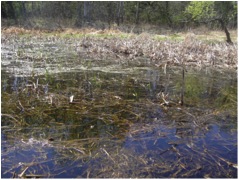
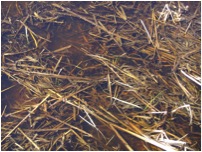
References
1. Discover Life in America. 2009.
http://www.dlia.org/atbi/species/Animalia/Arthropoda/Insecta/Coleoptera/Gyrinidae/index.shtml
2. Ferkinhoff, W.D., Gundersen R.W. 1983. A Key To the Whirligig Beetles of Minnesota and Adjacent States and Canadian Provinces (Coleoptera: Gyrinidae). Scientific Publications of the Science Museum of Minnesota, St. Paul, MN.
3. Foltz, J.L. 2001. ENY 3005 Family Identification (Coleoptera: Gyrinidae)
http://entomology.ifas.ufl.edu/foltz/eny3005/lab1/coleoptera/gyrinid.htm
4. Giude to Aquatic Invertebrates of the Upper Midwest. 2004. http://wrc.umn.edu/prod/groups/cfans/@pub/@cfans/@wrc/documents/asset/cfans_asset_115813.pdf
5. Milne, M., Milne, L. 1980. The Audubon Society Field Guide to North American Insects and Spiders. Alfred A. Knopf, Inc., New York, NY. Pp.543-544.
6. Van der Eijk, R.H. 1986. Population Dynamics of Gyrinid Beetles II. Reproduction. Oecologia. 69: 31-40.
Compiled by Holly Schiedermayer
Biodiversity & Evolution (BIOL 270) Professr Sarah Boyer. Spring 2010
Specimen collected at Macalester College’s Katharine Ordway Natural History Study Area on April 15, 2010.